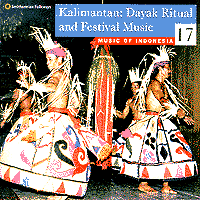 Music Of Indonesia 16-Music From The Southeast
Music Of Indonesia 16-Music From The Southeast
Music Of Indonesia 17-Kalimantan: Dayak Ritual And Festival Music
Smithsonian Folkways (www.si.edu/folkways)
It requires a fair amount of audacity to put out 17 CDs of any of the world's regional music. And note, that's 17 to date. Yet these last two volumes in the Smithsonian Folkways Music of Indonesia series continue to make the case for such an undertaking that just might leave you wishing for-dare I say it?-more! Recall that Indonesia contains more than 300 ethnic groups that inhabit about 3,000 of the archipelago's 13,700 islands and one will appreciate the enormous variety of music available and the selection needed even to begin to present the music of such a region.
With what must stand as about the best series of liner notes published today, the Music of Indonesia series allows for exploration of historical, cultural, and musicological background to each of the island groups surveyed. Music From The Southeast (Volume 16) explores the music of the island group to the east of Bali ("Nusa Tengarra" in Indonesian, the "Lesser Sundas" in English). In biologic terms, this area reflects the transition between the animal species found in Asia and those found in Australia.
Musically, diversity also abounds, as linguistic and religious differences add distinction along the various east-west subdivisions that have been depicted by anthropologists working in the area. You'll hear various types of melodic and non-melodic gong ensembles (similar to but distinct from the familiar gamelan), examples of group and/or devotional singing, percussion, and plucked string instruments. The purposes vary but may include weddings, dance accompaniment or even martial arts events. Begin, though, with a pair of songs, one about "a difficult journey by sailboat from Bima to Gunung... The mast breaks, the sail is lost, there are no oars," the other about a prince whose pleas of love to a princess are rejected. On selections featuring plucked lutes, various scales are demonstrated, and various types of gong ensembles are explored. On Timor alone, there are fourteen different ethnic groups, most with their own distinct language. Volume 16 includes three different types of music ensemble from Timor: gong ensembles; ensembles of violin, guitar, and vocals; and antiphonal singing for communal circle dances.
I know there are those who live for this music and they will love all of these Music of Indonesia volumes. Those folks are easy. What is more encouraging is that with liner notes as good as you get with Smithsonian Folkways, even a novice can be enjoying these tracks in no time. This music is more than ethnomusicological indulgence; you will be amazed how quickly sounds that might be a reach for many will soon capture your ear and imagination.
Kalimantan: Dayak Ritual and Festival Music (volume 17) explores music from seven Dayak groups from Kalimantan (Indonesian Borneo). Borneo, the world's third largest island, is located nearly evenly along the equator. "Dayak" refers generally to groups whose ancestral homeland was interior Borneo, but through time appears to reflect movement and change as various groups settled about the island. An earlier Music of Indonesia (volume 13) focused on the stringed instruments of Kalimantan. Here, the coverage is on ensembles that don't use stringed instruments. So you'll hear a variety of gong and bamboo ensembles, choral and solo singing, and drumming. It would be a disservice to the liner notes to even begin to describe what they so effectively and capably manage as metrical, percussive and melodic differences are explained. Music of Indonesia 17, like the volumes before it, provides an array of geographic examples that compare and contrast. And while I understand that the specialist will find shortcomings in what is only a sampling from Kalimantan, this introduction to Borneo's music may well take a beginning listener down musical paths that will go on forever.
It's a wonderful series, but there's one small quibble: the detailed liner notes do end up in awfully small print. An eventual book format would be welcome, especially since the notes make it clear that voluminous background is available to these introductory compilations. - Richard Dorsett
